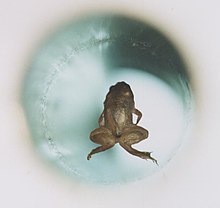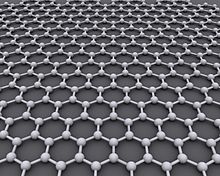Andre Geim
Sir Andre Konstantin Geim ( Russian Андрей Константинович Гейм / Andrei Konstantinovich Geim . Scientific transliteration Andrej Konstantinović Gejm ; German: Andre Konstantinovich Geim * 21st October 1958 in Sochi , Russian SFSR , Soviet Union ) is a Dutch - British physicist of German-Russian origin. In 2010 he and Konstantin Novoselov were awarded the Nobel Prize in Physics for their research on graphs .
Another of his remarkable scientific achievements is the development of a biomimetic adhesive , which later became known in the English trade press as gecko tape . His experiments with the help of diamagnetic levitation technology, which produced the so-called "levitating frog", are also well known. For the "hovering frog" he received the Ig Nobel Prize of 2000 in physics. This makes him the only person who is also a Nobel and Ig Nobel Prize winner.
Life
Geim's parents - Konstantin Alexejewitsch Geim (1910–1998) and Nina Nikolaijewna Bayer (* 1927) - were both engineers. Except for one Jewish great-grandmother, his ancestors belonged to the Russian-German minority. Geim's grandfather Nikolai Bayer was a professor of cartography at the University of Kharkiv in the Ukraine and briefly held a political office in the Ukrainian People's Republic under Petlyura after the First World War . Until the time of the German invasion of the Soviet Union in 1941, his father was a teacher of mathematics and physics at the University of Saratov . Because of their political "offenses" and their ethnic origin, both father and grandfather spent many years as slave labor in the Siberian gulag .
Andre Geim grew up in Sochi for the first six years and then moved with his parents to nearby Nalchik at the foot of the Caucasus Mountains, where he attended school. In particular, the math classes at the school there were of an extremely high standard. After graduating from school at the age of sixteen with a very good diploma, Geim applied for admission to the National Research University for Physics and Engineering in Moscow (MIFI). Although he solved the exam topics of the entrance exam well to his own liking, he failed the exam. He also had the feeling that he had received much more difficult exam questions than had previously been the case. After a year of intensive preparation, in which he surpassed all of his teachers in mathematics, Geim took the repeat exam at the MIFI. During the written exam, he noticed that all the candidates in his room either had names that sounded Jewish or other non-Russian names, while other exam groups consisted only of Russians. Geim and all his fellow candidates from the same room did not pass the exam, although Geim felt that he was able to solve the given tasks well. Disappointed by this ethnic discrimination (ethnicity was noted in the identity card and all official documents in Soviet times), he applied to the Moscow Institute of Physics and Technology and had to re-sit a new entrance examination. In the interview he was asked if he spoke German, to which he denied, whereupon the remark “Then he is not a real German!” Fell and he finally passed the entrance exam. During his later academic training, Geim faced repeated ethnic discrimination and was cursed as a “fascist” or “damned Jew”. He was only called “Russian” for the first time at the age of 32. On the occasion of the Nobel Prize award ceremony in 2010, Geim was asked which nationality he felt he belonged to (Russian-British-German-Dutch-Jew). He described himself as a " European ".
From 1976 he studied at the Moscow Institute of Physics and Technology and graduated in 1982. In 1987 he graduated as a candidate of science at the Institute of Solid State Physics of the Russian Academy of Sciences in Chernogolovka . He then worked as a post-doctoral student at VT Petrashov at the Institute for Problems in Microelectronic Technology (IPTM) in Chernogolovka. After the dissolution of the state structures of the Soviet Union, he moved to the University of Nottingham in 1990 . Further postdoc positions were at the University of Bath , briefly in Copenhagen and again in Nottingham before moving to Radboud University in Nijmegen in 1994 . Geim rejected appointments to professor at the Universities of Nijmegen and Eindhoven because he found the Dutch university system “too hierarchical and full of petty politicking” (“too hierarchical and full of petty personnel policy”). Geim returned to the UK and accepted an appointment from Manchester University in 2001 . He is currently Director of the Manchester Center for Mesoscience and Nanotechnology and chair of condensed matter physics . He also holds the title of Langworthy Research Professor, a title that used to be a. a. Ernest Rutherford , Lawrence Bragg and Patrick Blackett held.
In 2004 Andre Geim succeeded in producing the first two-dimensional crystals from carbon atoms ( graphene ). For this discovery Geim was awarded the 750,000 in April 2009 Euro doped Körber Prize awarded. On October 5, 2010, Geim and Konstantin Novoselov were awarded the Nobel Prize for Physics “for fundamental experiments with the two-dimensional material graphene”.
When in 2013, on the occasion of the jubilee of Elizabeth II Regius, professorships were to be donated, the jury chose the Department of Physics at the University of Manchester. Andre Geim became the first Regius Professor of Physics , while Novoselov took the Langworthy Professorship.
Geim is the author of more than 300 scientific articles in peer-reviewed journals, including over 35 in the journals Nature and Science (as of 2011). Its h-index is> over 100; over 20 of his publications have been cited more than 1000 times and four of them more than 10,000 times.
Awards
- 2000: Ig Nobel Prize with Michael Berry
- 2007: Mott Medal
- 2007: Member of the Royal Society
- 2008: EuroPhysics Prize together with Konstantin Novoselov
- 2009: Körber Prize
- 2010: John J. Carty Award
- 2010: Nobel Prize in Physics together with Konstantin Novoselov
- 2010: Commander in the Order of the Dutch Lion
- 2012: Accolade as Knight Bachelor in the New Year Honors by Queen Elizabeth II ; he was raised to the nobility .
- 2012: Admission to the National Academy of Sciences
- 2013: Copley Medal from the Royal Society
Web links
- Homepage at Manchester University. In: physics.manchester.ac.uk.
- Videos by and about Andre Geim in the AV portal of the Technical Information Library
Footnotes
- ↑ a b One-page curriculum vitae. (doc) In: physics.manchester.ac.uk. Retrieved January 26, 2018 .
- ↑ a b CV from July 7, 1976. Archived from the original on July 20, 2011 ; Retrieved October 6, 2010 (Russian).
- ↑ a b c A physicist of many talents . In: Physics World . February 2006, p. 8 (English, physicsworld.com [PDF; accessed January 26, 2018]).
- ^ Student's Certificate. Archived from the original on July 20, 2011 ; Retrieved January 1, 1970 .
- ^ KS Novoselov et al .: Electric Field Effect in Atomically Thin Carbon Films. In: Science. Volume 306, 2004, p. 666, doi : 10.1126 / science.1102896
- ↑ It's a thinner winner. October 19, 2006, archived from the original on April 23, 2008 ; Retrieved January 1, 1970 .
- ↑ BBC News : Gecko inspires sticky tape . June 1, 2003
- ^ High Field Magnetic Laboratory at Radboud University Nijmegen: The Frog That Learned to Fly
- ↑ a b Michael Berry , Andre Geim: Of Flying Frogs and Levitrons . In: European Journal of Physics . tape 18 , 1997, p. 307–313 , doi : 10.1088 / 0143-0807 / 18/4/012 ( iop.org [PDF; accessed January 26, 2018]).
- ↑ a b c Autobiography. Retrieved March 7, 2013 .
- ↑ Карта сервера: Гейм, Андрей Константинович ( Memento from October 10, 2010 in the Internet Archive )
- ↑ nanotech.net: Andre Geim
- ^ The Nobel Prize in Physics 2010: Andre Geim, Konstantin Novoselov. Nobel Foundation, accessed on March 7, 2013 .
- ^ ANP: Lintje voor Nobelprijswinnaars. In: Brabants Dagblad . November 24, 2010, archived from the original on March 10, 2012 ; Retrieved September 10, 2011 (Dutch).
| personal data | |
|---|---|
| SURNAME | Geim, Andre |
| ALTERNATIVE NAMES | Гейм, Андрей Константинович (Russian); Geim, Andrei Konstantinowitsch (Russian, transcribed); Gejm, Andrej Konstantinovič (scientific transliteration) |
| BRIEF DESCRIPTION | Russian-Dutch-British physicist |
| DATE OF BIRTH | October 21, 1958 |
| PLACE OF BIRTH | Sochi |



